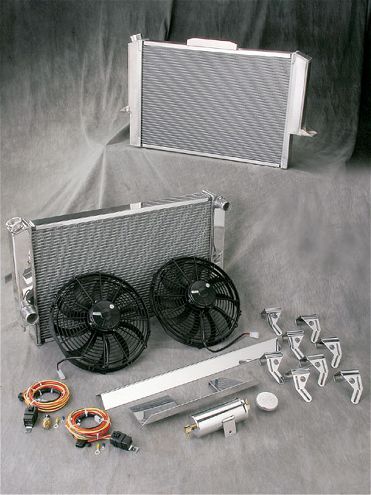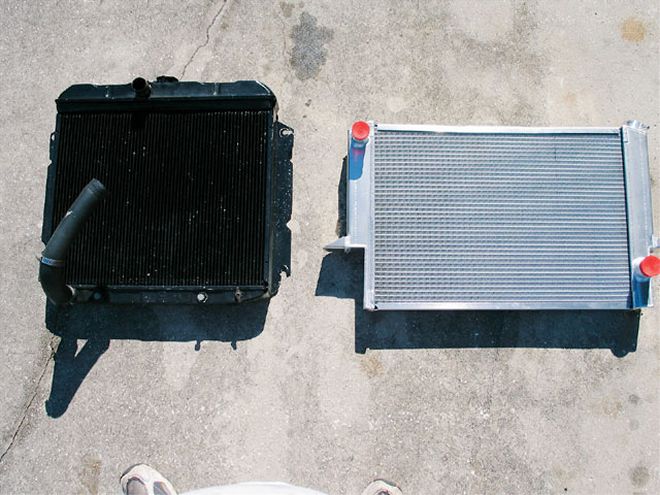
 Be Cool offers several styles of radiators, from just a radiator to the complete-package modules. All radiators and accessories come in either an unpolished or a polished finish.
Be Cool offers several styles of radiators, from just a radiator to the complete-package modules. All radiators and accessories come in either an unpolished or a polished finish.
Keeping your cool-it's not just a good idea for people; our Mopars also need to keep their cool. Nothing is more embarrassing than pulling into a local hot spot and having your ride puke green slimy liquid all over the ground. We spend countless hours dreaming, planning, and finally building an engine with enough power to launch the space shuttle, but none on how to keep it cool.
The radiator in front of your engine is basically a heat exchanger. It is designed to transfer the heat generated to it by the flow of hot coolant that flows through it. This cooling effect is aided by air blowing over and through it, developed by the fan. Most cars built in the last few years use aluminum radiators, but initially automotive radiators were built primarily of copper and brass. These two elements are efficient in heat transfer, but recently there has been a dramatic shift towards aluminum. One of the leading questions is: Does an aluminum radiator cool better than a copper and brass radiator? According to some experts, aluminum radiators generally do cool better than copper and brass radiators. for example, let's compare an aluminum radiator built with two rows of 1-inch-wide tubes with a copper/brass radiator. When compared to a copper and brass radiator, it would take five rows of 1/2-inch tubes (the usual dimension of the copper/brass tube), to be as efficient as the two 1-inch aluminum cores. An aluminum radiator provides higher efficiency, is lightweight, and has a longer life expectancy than a copper and brass one.
Another frequently asked question: Will an aluminum radiator decrease the operating temperature of my engine? A decrease in engine temperature not only depends on the radiator itself, but also other facets of your cooling system. the fuel your engine uses, moisture, pulley ratios, and timing dramatically effect engine temperatures.
 After the old radiator is out, placement of the new one is pretty straight forward. The crossflow design is a lot more efficient than the vertical flow our Mopars came from the factory with.
After the old radiator is out, placement of the new one is pretty straight forward. The crossflow design is a lot more efficient than the vertical flow our Mopars came from the factory with.
We recently gave Be Cool a call to see what it would take to cool a pair of our project cars. The first car is our own project Valiant Effort. The stock-style copper and brass radiator we have been using was dutifully holding the Valiant at around 190-195 degrees. But we knew the stock 360 was going to be upgraded-and since the new engine would have a larger amount of horsepower than the stocker-a new aluminum engine heat transferer (radiator) would be nice addition. The second recipient would be none other than the Holley Road Runner project we have covered in these pages. The Holley Road Runner has been such a well-received project we decided to keep it around for a while. we will now be referring to it as Project M. The first step for Project M is the installation of a big ol' 8-71 blown 500-inch wedge engine by Indy Cylinder Heads. Supercharged engines make more than just horsepower. heat is also generated and places a heavy demand on a cooling system.
We ordered an aluminum radiator for the Valiant, and Project M got the full-boogie radiator and module kit. The module kit consists of the radiator, twin electric cooling fans, and the necessary wiring. Since we were installing crossflow radiators in both cars, we were curious to see how much work is really involved.
We know what you're thinking-How can I justify changing my stock-style radiator over to a Be Cool unit? If you're a numbers-matching kind of guy, the answer is you can't. Lets face it, it's an aftermarket aluminum radiator. But if you are looking for the ultimate in cooling capability for a slightly modified street stalker all the way to a full-blown, mack-daddy, behemoth of a race car, it's simple-the drop in engine temperature will ensure your engine keeps its cool under almost any circumstance. And let's not forget there are other factors that relate to engine temperature: timing, water flow, and sufficient airflow through the radiator are a must.